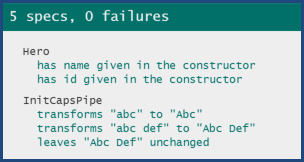We’ll test an Angular pipe in this chapter
An Angular pipe is a declarative way in HTML to transform some input into some displayable output.
We’ll look at our app’s custom InitCapsPipe that converts a string of words into a string of capitalized words.
We use it our hero-detail.component.html template to turn a hero name like “eeny weenie” into “Eeny Weenie”
{{hero.name | initCaps}} is {{userName}}'s current super hero!
The code for InitCapsPipe in init-caps-pipe.ts is quite brief:
import {Pipe} from 'angular2/angular2';
@Pipe({ name: 'initCaps' })
export class InitCapsPipe {
transform(value: string) {
return value.toLowerCase().replace(/(?:^|\s)[a-z]/g, function(m) {
return m.toUpperCase();
});
}
}
In this chapter we will:
- add the Angular 2 library to our test harness
- test this custom Angular pipe class
- load multiple test files in our test harness, using system.js
The Unit Testing chapters build upon each other. We recommend reading them in order.
We're also assuming that you're already comfortable with basic Angular 2 concepts and the tools
we introduced in the QuickStart and
the Tour of Heroes tutorial
such as npm, gulp, and live-server.
Add the Angular library
Looking back at unit-tests.html we realize that we have not loaded the Angular library.
Yet we were able to load and test the application’s Hero class.
We were lucky! The Hero class has no dependence on Angular.
If it had depended on Angular, we’d still be staring at the Jasmine “big-time fail” screen:

If we then opened the browser’s Developer Tools (F12, Ctrl-Shift-I) and looked in the console window, we would see that SystemJS tried to load Angular and couldn't find it.
We are writing an Angular application afterall and
we were going to need Angular sooner or later. That time has come.
The InitCapsPiep clearly depends on Angular as is clear in the first few lines:
import {Pipe} from 'angular2/angular2';
@Pipe({ name: 'initCaps' })
export class InitCapsPipe {
Open unit-tests.html
Find the src="../node_modules/systemjs/dist/system.src.js"></script>
Replace Step #1 with these two scripts:
<!-- #1. add the system.js and angular libraries -->
<script src="../node_modules/systemjs/dist/system.src.js"></script>
<script src="../node_modules/angular2/bundles/angular2.dev.js"></script>
Add another spec file
Create an init-caps-pipe.spec.ts* next to init-caps-pipes.ts in src/app
Stop and restart the TypeScript compiler to ensure we compile the new file.
Add the following lines of rather obvious Jasmine test code
import {InitCapsPipe} from './init-caps-pipe';
describe('InitCapsPipe', () => {
let pipe:InitCapsPipe;
beforeEach(() => {
pipe = new InitCapsPipe();
});
it('transforms "abc" to "Abc"', () => {
expect(pipe.transform('abc')).toEqual('Abc');
});
it('transforms "abc def" to "Abc Def"', () => {
expect(pipe.transform('abc def')).toEqual('Abc Def');
});
it('leaves "Abc Def" unchanged', () => {
expect(pipe.transform('Abc Def')).toEqual('Abc Def');
});
});
Note that each test is short (one line in our case). It has a clear label that accurately describes the test. And it makes exactly one expectation.
Anyone can read these tests and understand quickly what the test does and what the pipe does. If one of the tests fails, we know which expected behavior is no longer true. We’ll have little trouble maintaining these tests and adding more like them as we encounter new conditions to explore.
That’s the way we like our tests!
Add this spec to unit-tests.html
Now let’s wire our new spec file into the HTML test harness.
Open unit-tests.html. Find System.import('app/hero.spec').
Hmm. We can’t just add System.import('app/init-caps-pipe.spec').
The first System.import returns a promise as does this second import.
We can’t run any of the Jasmine tests until both imports are finished.
Fortunately, we can create a new Promise that wraps both import promises and waits
for both to finish loading.
// #3. Import the spec files explicitly
Promise.all([
System.import('app/hero.spec'),
System.import('app/init-caps-pipe.spec')
])
Try it. The browser should refresh and show

We have a pattern for adding new tests.
In future, when we add a new spec, we add another System.import('app/some.spec') to
the array argument passed to Promise.all.
What’s Next?
Now we can test parts of our application that we load asynchronously with system.js.
What about testing parts that are themselves asynchronous?
In the next chapter we’ll test a service with a public asynchronous method that fetches heroes from a remote server.